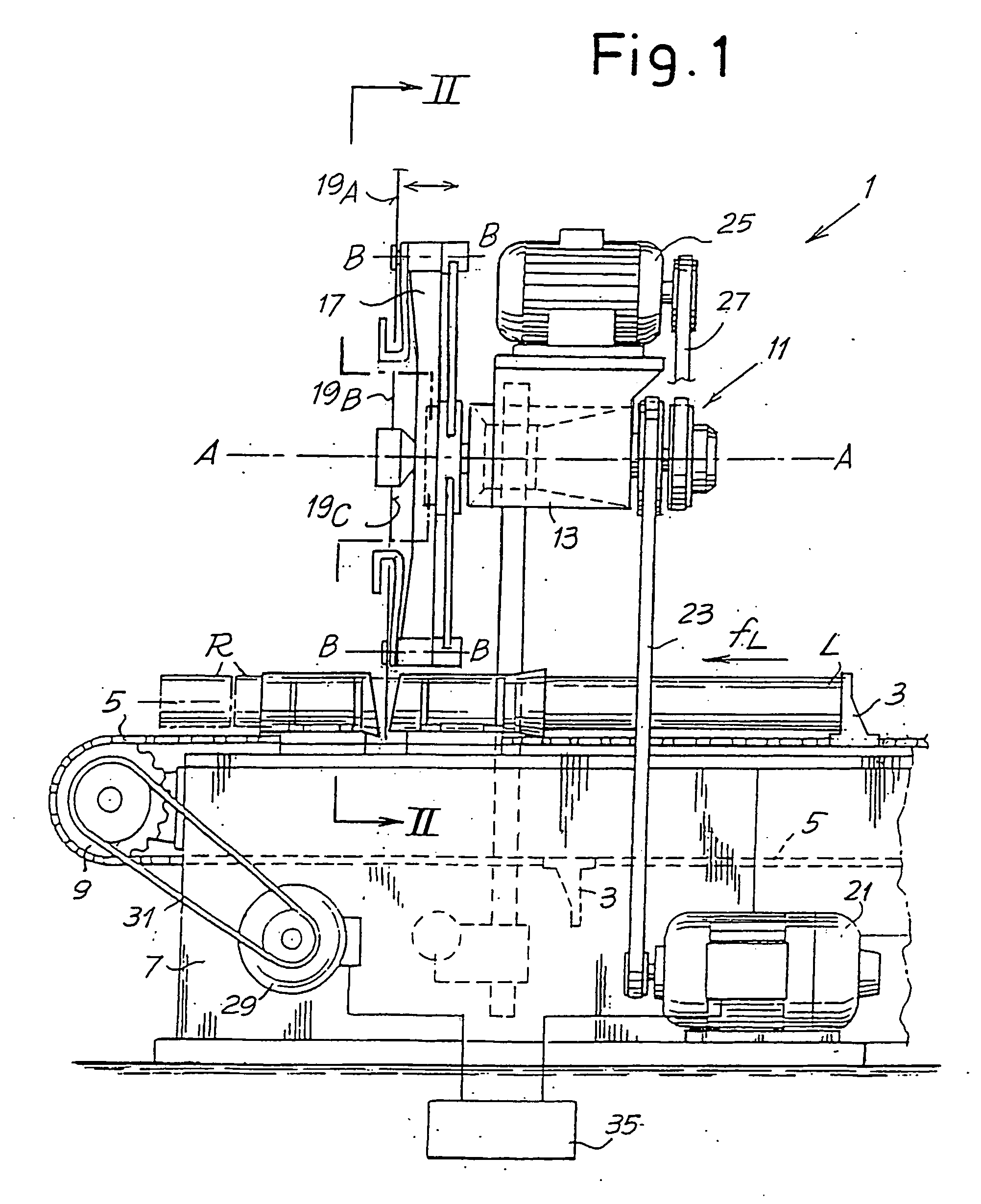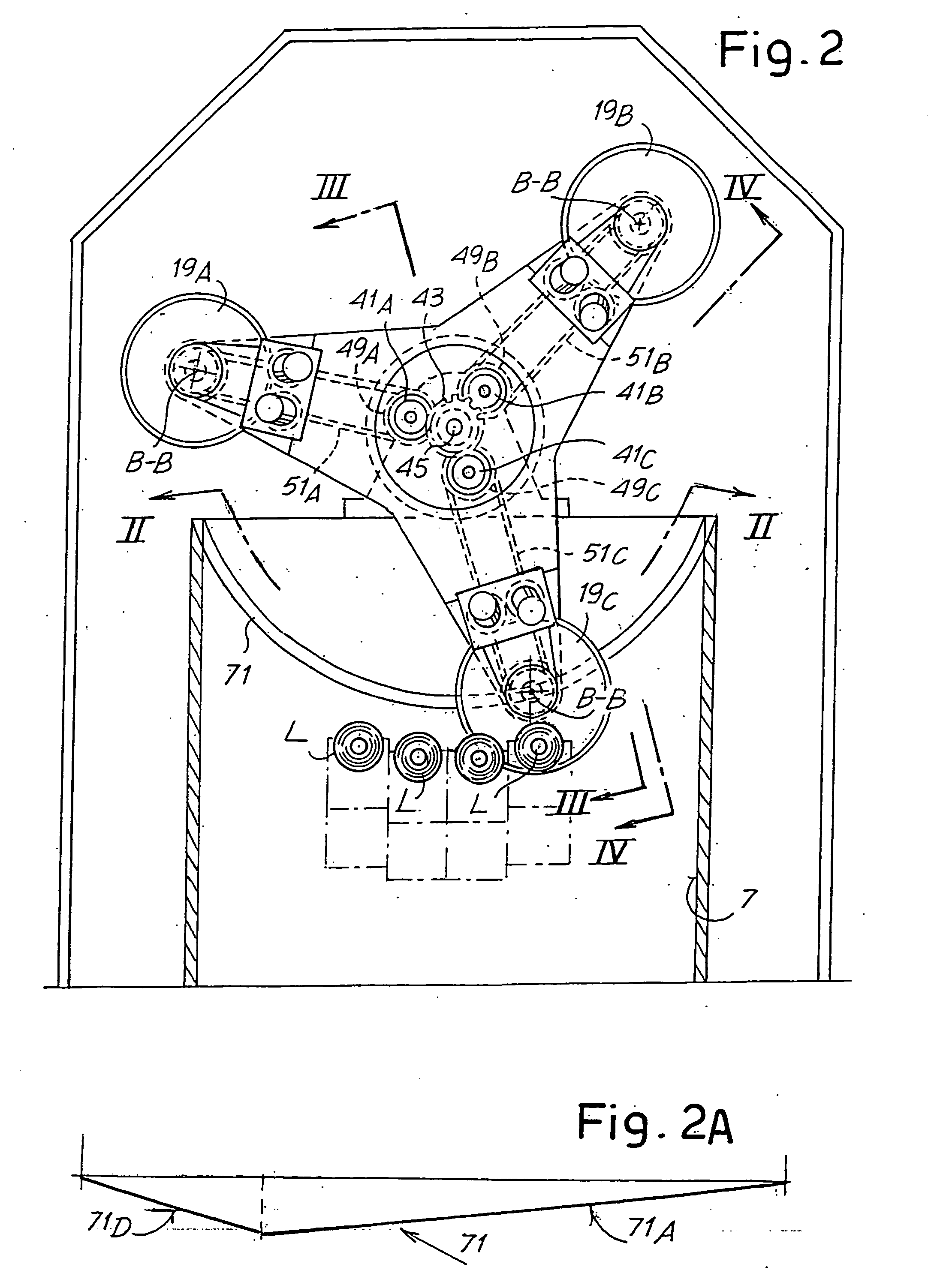Cutting machine for cutting elongated products
a cutting machine and elongated technology, applied in metal working equipment, manufacturing tools, tobacco, etc., can solve the problems of considerable tracking error between the blade and the log, inability to use a blade with alternate motion, and inability to meet the needs of customers, etc., to achieve high production rates, simple arrangement and structure, and high production flexibility
- Summary
- Abstract
- Description
- Claims
- Application Information
AI Technical Summary
Benefits of technology
Problems solved by technology
Method used
Image
Examples
first embodiment
[0042] With reference to the FIGS. 2 and 3, which show the machine according to the invention, these show how the rotating element 17, drawn in rotation by the hub 17A, has three toothed wheels inside it, disposed at 120° from one another around the axis A-A, indicated with 41A, 41B and 41C. Said wheels mesh with a central toothed wheel 43 keyed onto a shaft 45, which receives motion from the motor 25 through the belt 27.
[0043] The toothed wheels 41A, 41B and 41C are keyed onto respective spindles 47A, 47B and 47C onto which toothed pulleys 49A, 49B and 49C are in turn keyed. Each of the toothed pulleys 49A, 49B, 49C transmits the motion supplied by the motor 25, through toothed belts 51A, 51B, 51C, to the rotating disk-shaped cutting blades 19A, 19B and 19C.
[0044] As can be seen in the detail in FIG. 5 for the blade 19C and in the detail in FIG. 6 for the blade 19A, the toothed belt 51A, 51B, 51C transmits motion to a toothed pulley 53A, 53B, 53C keyed onto an axis 55A, 55B and 55...
second embodiment
[0062]FIG. 4 shows a side view of the rotating element 17 in the cutting machine according to the invention. The same numbers indicated the same or equivalent parts to those of the previous embodiment. The variation lies in the different way in which alternate movement is transmitted to the three disk-shaped blades 19A, 19B, 19C supported by the rotating element 17. While in the previous case each disk-shaped blade was supported by a sleeve equipped with a feeler 67A, 67B or 67C cooperating with a single annular cam 71, in this case the sleeves that carry the shafts 55A, 55B and 55C of the blades 19A, 19B and 19C cooperate with three respective rockers 121A, 121B and 121C hinged in X to the rotating element 17 and bearing (at the opposite end from the one cooperating with the supporting sleeves of the rotating disk-shaped blades 19A, 19B, 19C) small wheels 123A, 123B and 123C cooperating with an annular cam 125 disposed coaxially around the axis A-A of rotation of the rotating eleme...
PUM
| Property | Measurement | Unit |
|---|---|---|
| Electric charge | aaaaa | aaaaa |
| Current | aaaaa | aaaaa |
| Digital information | aaaaa | aaaaa |
Abstract
Description
Claims
Application Information
 Login to View More
Login to View More - R&D
- Intellectual Property
- Life Sciences
- Materials
- Tech Scout
- Unparalleled Data Quality
- Higher Quality Content
- 60% Fewer Hallucinations
Browse by: Latest US Patents, China's latest patents, Technical Efficacy Thesaurus, Application Domain, Technology Topic, Popular Technical Reports.
© 2025 PatSnap. All rights reserved.Legal|Privacy policy|Modern Slavery Act Transparency Statement|Sitemap|About US| Contact US: help@patsnap.com



